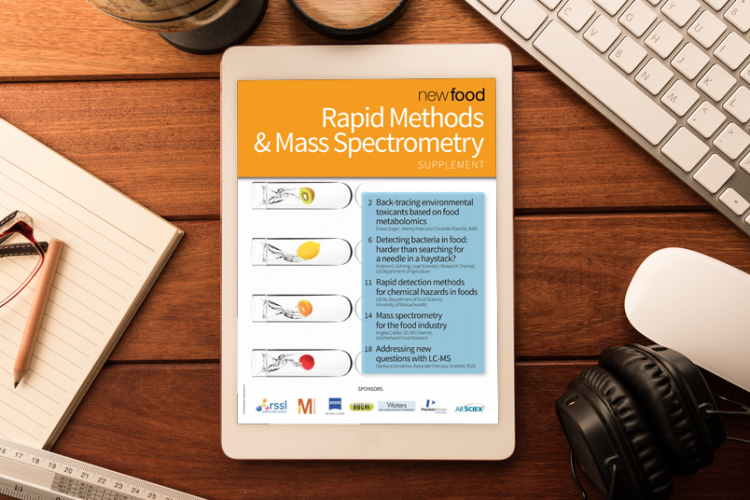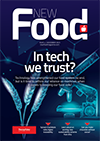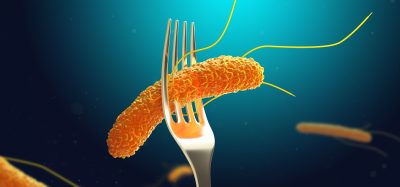Rapid Methods & Mass Spectrometry supplement 2013
- Like
- Digg
- Del
- Tumblr
- VKontakte
- Buffer
- Love This
- Odnoklassniki
- Meneame
- Blogger
- Amazon
- Yahoo Mail
- Gmail
- AOL
- Newsvine
- HackerNews
- Evernote
- MySpace
- Mail.ru
- Viadeo
- Line
- Comments
- Yummly
- SMS
- Viber
- Telegram
- Subscribe
- Skype
- Facebook Messenger
- Kakao
- LiveJournal
- Yammer
- Edgar
- Fintel
- Mix
- Instapaper
- Copy Link
Posted: 2 January 2014 | New Food | No comments yet
Back-tracing environmental toxicants in an animal-derived food chain based on food metabolomics
Detecting bacteria in food: harder than searching for a needle in a haystack?
Rapid detection methods for chemical hazards in foods
Mass spectrometry for the food industry


This free to view Rapid Methods & Mass Spectrometry supplement is sponsored by RSSL, Merck Millipore, Carl Zeiss, BÜCHI, Waters, PerkinElmer and AB Sciex.
- Back-tracing environmental toxicants in an animal-derived food chain based on food metabolomics
Authors: Erwan Engel, Jérémy Ratel and Christelle Planche (INRA, UR370 QuaPA Research Unit, Microcontaminants, Aroma and Separation Science (MASS) Group)
Food-producing animals are exposed to toxic micropollutants via their environment and feeds. These micropollutants represent a chemical human health hazard because they are capable of entering the animals and being transferred to edible tissues. Most current approaches to assessing contamination levels in foods are based on high performance analytical methods designed to determine the concentration of targeted micropollutant residues present down to trace levels in the food… - Detecting bacteria in food: harder than searching for a needle in a haystack?
Author: Andrew G. Gehring, Lead Scientist / Research Chemist, US Department of Agriculture, Agricultural Research Service
It would have been easier to find a needle in a haystack than to locate variables needed to ‘simply’ compute the relative difficulty of that task! Although I am employed by the US Department of Agriculture, before writing this article I never knew that there are at least three haystack configurations that vary in volume and weight depending upon the species of grass, drying time, rainfall, packing density, etc… - Rapid detection methods for chemical hazards in foods
Author: Lili He, Department of Food Science, University of Massachusetts
Foodborne illnesses caused by chemical and microbial hazards are an important health concern in the United States. The new FDA Food Modernisation Safety Act emphasised the need for better detection of and response to food safety problems. Rapid detection methods are critical to prevent the contaminated foods into the market chain as well as to track contaminated food back to the source in an effective, timely manner. To detect the targets in a complex food matrix, there are two critical steps involved; separation and identification… - Mass spectrometry for the food industry
Author: Angela Calder, GC-MS Chemist, Leatherhead Food Research
Mass spectrometry is a powerful analytical technique which can be used for the detection and subsequent identification of a wide range of compounds. In the food industry, it can be used in taint investigations, flavour profiling and shelf life studies as well as qualitative and quantitative analysis of specific compounds of interest…
This Rapid Methods & Mass Spectrometry supplement is restricted - login or subscribe free to access


Why subscribe? Join our growing community of thousands of industry professionals and gain access to:
- bi-monthly issues in print and/or digital format
- case studies, whitepapers, webinars and industry-leading content
- breaking news and features
- our extensive online archive of thousands of articles and years of past issues
- ...And it's all free!
Click here to Subscribe today Login here
Issue
Related topics
Related organisations
AB Sciex, BUCHI, Carl Zeiss, INRA, Leatherhead Food Research, Merck, PerkinElmer Inc







